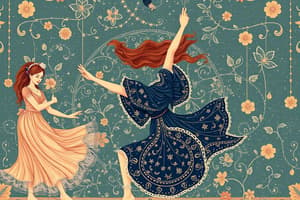Podcast
Questions and Answers
Physical activity is defined as any movement produced by skeletal muscles resulting in energy expenditure above resting levels.
Physical activity is defined as any movement produced by skeletal muscles resulting in energy expenditure above resting levels.
True (A)
Active recreation involves activities that require minimal energy and only involve observation.
Active recreation involves activities that require minimal energy and only involve observation.
False (B)
Socializing motive for recreation involves solitary activities like reading and item collection.
Socializing motive for recreation involves solitary activities like reading and item collection.
False (B)
Competitive motive for recreation tests the participant's limitations or their ability to compete against the environment.
Competitive motive for recreation tests the participant's limitations or their ability to compete against the environment.
Indoor recreation is normally done in an open environment exposed to unfavorable weather conditions.
Indoor recreation is normally done in an open environment exposed to unfavorable weather conditions.
Chess is a strategic board game played by one player on a checkered board.
Chess is a strategic board game played by one player on a checkered board.
The first living indication that chess existed was found in India around 500 C.E.
The first living indication that chess existed was found in India around 500 C.E.
According to history, chess was played around 600 C.E. in Persia and named Shatranj, meaning 'the king is safe' when the king could not escape from attack.
According to history, chess was played around 600 C.E. in Persia and named Shatranj, meaning 'the king is safe' when the king could not escape from attack.
Passive recreation requires direct participation or task completion.
Passive recreation requires direct participation or task completion.
Exploratory motive for recreation involves activities that expose oneself to a new environment, like hiking and diving.
Exploratory motive for recreation involves activities that expose oneself to a new environment, like hiking and diving.
Match the following chess pieces with their respective point values:
Match the following chess pieces with their respective point values:
Match the following chess pieces with their unique movement characteristics:
Match the following chess pieces with their unique movement characteristics:
Match the following chess pieces with their classification as a major or minor piece:
Match the following chess pieces with their classification as a major or minor piece:
Match the following chess pieces with their unique abilities:
Match the following chess pieces with their unique abilities:
Match the following chess pieces with their unique movement characteristics:
Match the following chess pieces with their unique movement characteristics:
Match the following chess pieces with their respective point values:
Match the following chess pieces with their respective point values:
Match the following chess pieces with their classification as a major or minor piece:
Match the following chess pieces with their classification as a major or minor piece:
Match the following chess pieces with their unique abilities:
Match the following chess pieces with their unique abilities:
Match the following recreational motives with their descriptions:
Match the following recreational motives with their descriptions:
Match the following statements about chess history with their corresponding details:
Match the following statements about chess history with their corresponding details:
Match the following types of recreation with their descriptions:
Match the following types of recreation with their descriptions:
Flashcards are hidden until you start studying
Study Notes
Physical Activity and Recreation
- Physical activity is defined as any movement produced by skeletal muscles resulting in energy expenditure above resting levels.
Recreation Motives
- Socializing motive for recreation involves solitary activities like reading and item collection.
- Competitive motive for recreation tests the participant's limitations or their ability to compete against the environment.
- Exploratory motive for recreation involves activities that expose oneself to a new environment, like hiking and diving.
Chess
- Chess is a strategic board game played by one player on a checkered board.
- The first living indication that chess existed was found in India around 500 C.E.
- Chess was played around 600 C.E. in Persia and named Shatranj, meaning 'the king is safe' when the king could not escape from attack.
Chess Pieces
- Chess pieces have unique movement characteristics, point values, classification as major or minor pieces, and unique abilities.
- Examples of chess pieces and their respective characteristics are not specified in the text.
Recreation Types
- Active recreation involves activities that require minimal energy and only involve observation.
- Indoor recreation is normally done in an open environment exposed to unfavorable weather conditions.
- Passive recreation requires direct participation or task completion.
Studying That Suits You
Use AI to generate personalized quizzes and flashcards to suit your learning preferences.



